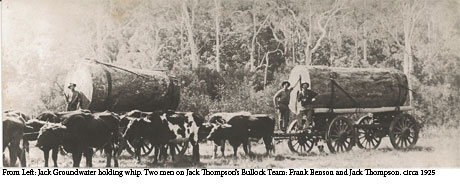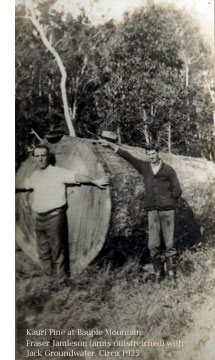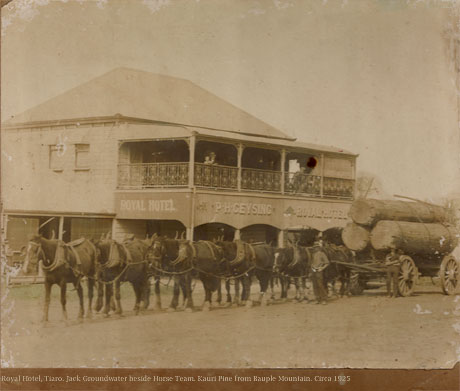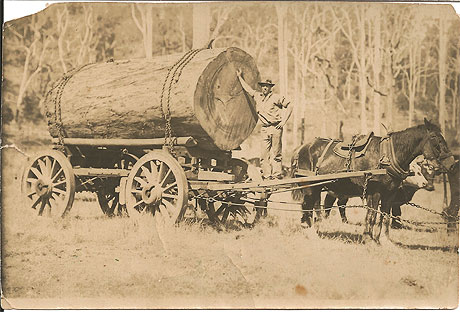
 |
|
Places Industries Families Stories
 |
The Early Timber Industry Timber getting or harvesting was the first economic venture in the area and has remained an important industry in the district. The following is a tribute to the early settlers skills and courage in clearing the scrub into the habitated district we have today.
Charles Augustus Stringer is the first recorded timber-getter to select land in the Bauple area in 1869 followed by Samuel Inker in 1870 and John Stratford in 1880. Later the Andrews brothers, James Isbister, Bob Cunningham, Henry Missing and the Connors family to name a few became involved in the Timber-getting. Edward Armitage who arrived in Maryborough in 1860’s has left one of the few records of the industry in those early days. He said, “Arriving in Maryborough I joined a party of timber-getters. The timber then grew in the virgin scrubs and forests on the banks of the rivers and creeks, the haulage was so short that only snigging chains and block wheel trolleys were needed. I once cut a pine tree mast for a vessel not far from the bank of the Mary River in Maryborough. I went to work in the log timber trade at Mt Boople with the Andrew brothers who are now growing sugar cane and cattle on the cleared scrub lands where they cut pine in the wilds 50 years ago.” In the early days the logs were snigged out of the forests by bullock team, loaded onto bullock wagons and carted to the Mary River and its tributaries, awaiting the river to rise high enough to float the logs (lashed together) to the Maryborough sawmills. Later they were taken to the nearest railhead or by horse team to the saw mills.
The logs were taken by bullock team to Gundiah and rail to the Ipswich workshops for making railway carriages. The timber-getters that cut this giant were Jack Groundwater and Fraser Jamieson. (Jim Groundwater said the diameter of the log was greater than the railway carriage, they had to cut grooves in the log to fit the pins in.) Above: Fraser Jamieson (left) and Jack Groundwater in front of timber brought from Bauple Mountain in 1925. Below: Jack Groundwater’s horse team in front of Tiaro‘s Royal Hotel.
|
|||
 The settlers were attracted to the district
by the great stands of timber, both hardwoods
and Hoop and Kauri Pines. In
the very early days, timber-getters made
no permanent settlements: they were
itinerant workers, equipped with axes,
wedges and cross cut saws, and often
with only their bullock teams and dogs
for company. Later as semi-permanent
tracks were carved through the seemingly
impenetrable scrub, some based
themselves near the foot of the mountain,
building slab huts to house their
wives and families.
The settlers were attracted to the district
by the great stands of timber, both hardwoods
and Hoop and Kauri Pines. In
the very early days, timber-getters made
no permanent settlements: they were
itinerant workers, equipped with axes,
wedges and cross cut saws, and often
with only their bullock teams and dogs
for company. Later as semi-permanent
tracks were carved through the seemingly
impenetrable scrub, some based
themselves near the foot of the mountain,
building slab huts to house their
wives and families. A feature article in the Sydney Mail, 1925
entitled “A Giant of the Queensland
Bush” gives some insight into both the
size of the trees felled in those days and
also the working conditions of timber
getters. “A well-known land mark for
over 40 years, it was the last of the big
giants and was growing on the side of
the mountain. 2 men worked on it for
3 months till they got it to level ground,
the old hands predicted failure–because
of the steepness of the gullies, it would
get away from them and bust itself-up. When the tree fell it wiped out an acre and a half of scrub. It yielded 16 logs
and 18,000 superficial feet, the length of
the trunk to the first limb was 60 feet.”
A feature article in the Sydney Mail, 1925
entitled “A Giant of the Queensland
Bush” gives some insight into both the
size of the trees felled in those days and
also the working conditions of timber
getters. “A well-known land mark for
over 40 years, it was the last of the big
giants and was growing on the side of
the mountain. 2 men worked on it for
3 months till they got it to level ground,
the old hands predicted failure–because
of the steepness of the gullies, it would
get away from them and bust itself-up. When the tree fell it wiped out an acre and a half of scrub. It yielded 16 logs
and 18,000 superficial feet, the length of
the trunk to the first limb was 60 feet.” 
